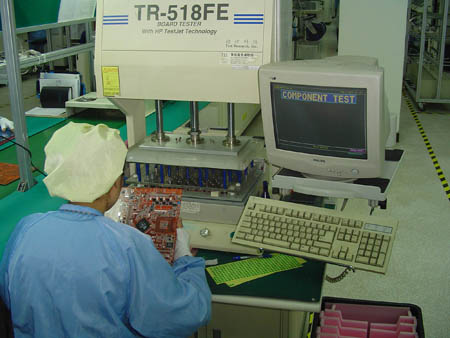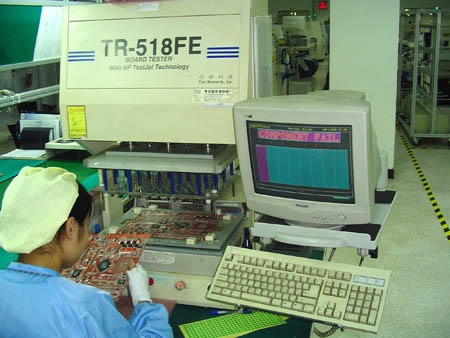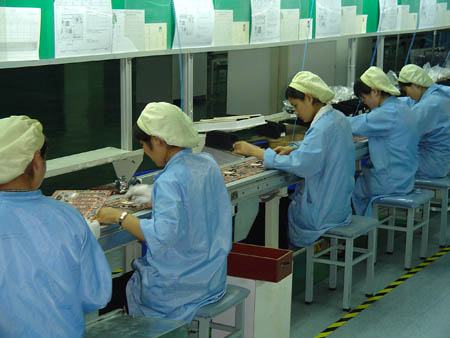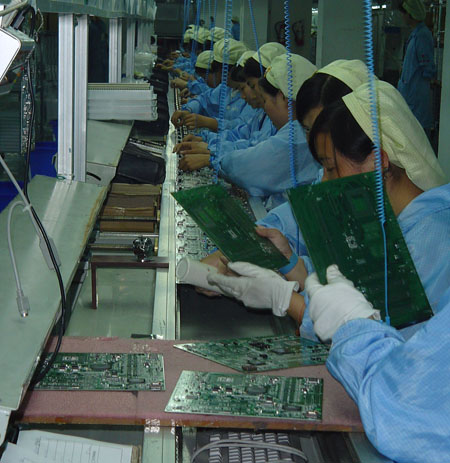The Birth of an Abit NF7 - A Factory Tour
by Kristopher Kubicki on June 11, 2004 10:12 PM EST- Posted in
- Motherboards
Assembly
On average, 1.4 out of 100 motherboards fail Rolly's quality assurance standards. These boards never leave the factory, but the cost of the components and manpower put into the motherboard are lost and translated onto the retail price. Efficiency of 98.6% is about average for a factory of this size. Although, Abit told us in the next several months that they are increasing funding to several projects,which should get this number closer to 99%. About 150 of the factory's 1400 employees are allocated solely to quality assurance testing.Above, you can see a specialized machine electrically testing the newly stamped SMDs on the motherboard. It is assumed that the PCB from the OEM is working correctly, so this is the first electrical test in the assembly process. Unfortunately, this poor NF7 does not pass inspection, even after several tries. The inspector places this board in a separate bin and it is sent to a reworking station where it undergoes manual electrical testing under oscilliscopes. The much higher skilled workers who test individual components with scopes are trained to solder or strip down a board depending on whether or not it can be reworked. Only after this stage does a bad motherboard get completely pitched. A short clip of an engineer testing a defunct board can be viewed below.
After successfully passing the first visual and electrical inspection tests, the half completed motherboard moves down to the epoch of manual labor - the assembly line. Here, 30 to 40 workers sit on the assembly line and plug components too large for SMT into the motherboard. This includes components like PCI slots, DIMM slots, capacitors, audio connectors, and anything big enough to place easily with your fingers. All of these components slide into the holes predrilled into the PCB before it comes to the factory. As we mentioned in the ECS factory tour, assembly workers are primarily female. In this particular region of the world, women usually work for less and are proven to have higher concentration at tasks such as small component assembly.
Again, you can see above the amount of manual labor used to plug components into the motherboard. Every few stations or so, a worker uses a barcode scanner to scan the board into a centralized Oracle database. Each board is tracked stringently via this system, which is also connected globally. Managers in Abit's USA or Taiwan office can watch a board undergo each stage of construction in their office via the Oracle database interface. This system also provides excellent backtracking if a board is found later to have faulty components or poor assembly. The idea is to control quality with the highest standards, and then refine the process as quickly as possible so that no boards in the future are corrupted.















19 Comments
View All Comments
KristopherKubicki - Sunday, June 13, 2004 - link
Got it, thanks.Kristopher
kalaap - Sunday, June 13, 2004 - link
"This is actually the second over on the production line; the first is used right after SMT."I think you meant second OVEN.
AtaStrumf - Sunday, June 13, 2004 - link
Right Click --> Save Target As... ---> save to disk and play from there. If its still not working you need a new player. Real One Player is preety good.roostercrows - Sunday, June 13, 2004 - link
can someone tell me which video players you guys use? i couldn't get my realplayer to download the videos. thanksDonB - Sunday, June 13, 2004 - link
"...why there are more women than men". Women have much better manual dexterity than men. Remember typing classes in high school? I remember in my class, after the first semester, the females were typing around 40-50 wpm while the males were typing around 25-35 wpm, almost without exception.CurtOien - Sunday, June 13, 2004 - link
"The machine technician and the traditional visual inspectors are paid about the same; usually around $100 per month with lodging."I wonder how much the executives make?
AtaStrumf - Sunday, June 13, 2004 - link
The problem that I see with their testing procedure is that they probably only test at default settings, which is just not good enough for an enthusiast targeted motherboard. Sure my KT7 A worked fine at 100 MHz FSB, but it didn't at 133 MHz FSB, and my latest AN7 works fine at default BIOS setting, but when you change something strange things start to happen.I understand that they're in a hurry, but they should at least test at the most stressful settings that the mobo is supposed to function properly i.e. 200 MHz FSB and not 133 or. 166 MHz. What good is a 24 h burn-in test if it's done at 133 MHz FSB, and I'm gonna be using a 200 MHz FSB.
For instance this AN7 that I have now, works perfectly if I OC my 2500+ with the default offered 3200+, but if I change the FSB manualy to 200 its totaly unstable. How strange is that?
KristopherKubicki - Sunday, June 13, 2004 - link
artifex: I have not heard that reason for using women over men in facilities.What other economic information were you interested in? I can add it to the article.
Kristopher
artifex - Sunday, June 13, 2004 - link
I couldn't get the n7_fail image to load (ironic), but other than that, everything was good.Is it still true that another reason why there are more women than men on the assembly line is because womens' hands are generally thought to be smaller, and more adept?
I'd like to see more of the background economic information like what you provided for this story, next time you do a plant tour, too.